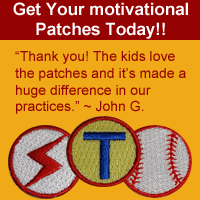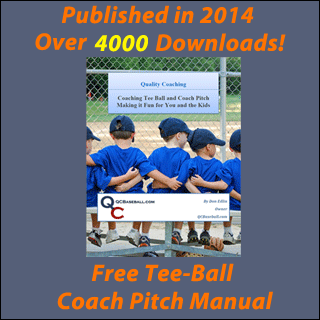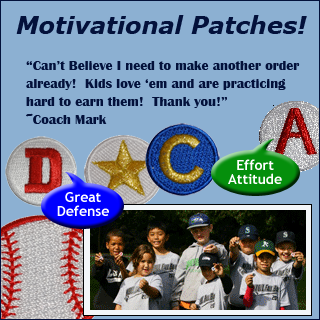Hitting - Vision
Introduction
At higher levels of baseball you'll hear players talk about coming out of slumps and often the reason they give is not some tweak in their stance or swing, they simply state that they are seeing the ball better. Now if professional players go through stages where they don't pick up the ball well, you can imagine that younger players of all ages not only have the same problem but we can safely add that many players don't even know how to pick up or focus on the ball.
The act of tracking the ball from the release of the pitcher's hand to the plate is difficult and a skill that needs to be practiced!
In addition, vision can be affected by the mental state of the player. Certainly a player doesn't go up to the plate thinking, "I'm not going to watch this pitch closely". Although a hitter would never be thinking that, it is often the result for many players for any number of reasons including: not knowing what to look for; not being focused on what's important; not having the proper mental approach; being concerned about other aspects of the swing or the game. Of all the terminology that is thrown around baseball, one statement that makes complete sense during a game is a hitting philosophy of "see the ball, hit the ball". A player may have a textbook perfect swing but if you put him up to the plate and tell him to close his eyes, he won't hit a thing. A player must know the importance of good vision at the plate and he needs to practice skills that will help him see the ball better.
Vision Problems
If you have been trying hard to pick up the ball early when hitting but really struggle to see the ball well, the first thing to check is your eyesight. If you haven't had you eyes checked in a few years it might be a good idea to do so. You can't make up for an eyesight problem with concentration, so if you think problems at the plate may be related to eyesight problems, you need to have the eyesight problem fixed before you can expect success at the plate.
I talked to a parent recently who said her son had been playing baseball for 3 years and had really struggled the first 2 years making contact at the plate. After the second year he was at the doctor and got an eye exam. Turns out he needed glasses. Third year he was seeing the ball and hitting the ball. Too bad he wasted 2 seasons before he got the problem corrected.
Head and Eye Position

Some vision problems start with the stance. Now with most rules, I've seen exceptions to this in some great hitters, but I believe it's easier to pick up and judge the baseball when you have your eyes level and both eyes are able to pick up the pitcher with ease. In image v1 you'll see that the player has his chin tucked in to his shoulder and although he can see the pitcher with both eyes, the position of the shoulders and head do not look relaxed. In addition his head is tilted which prevents him from picking up the pitch with his eyes level.
We've talked about the importance of balance from the stance throughout the entire swing, so we want to make sure we put our head and eyes in a position to support that balance. Keeping your head level with both eyes on the pitcher helps achieve that goal of being balanced from beginning to end.
Activity: In the last lesson we worked on coming up with a comfortable and relaxed stance and we didn't discuss head position much at that time because I wanted to make sure it wasn't overlooked with everything else you were working on. You'll need a parent or someone else for this activity. Have a parent stand about 10-15 feet in front of you. Now take your stance using your parent as a guide for where the pitcher is standing. The other person will now look to see if your
• Head is turned toward them, making it easier for the player to see the pitcher with both eyes.
• Eyes are very close to being level.
• Does the player look comfortable and relaxed?
It may be a benefit if you have a digital camera to take a pitcher of the player from this position so he can see what he looks like from the perspective of the pitcher.
Corrections: If you are unable to turn your head toward the pitcher and keep it level, you may need to change more than just your head position to correct this problem. Often your stance has put you in a position where you can't comfortably turn your head around far enough to see the pitcher with both eyes. If you took the last lesson to heart and came up with a balanced stance that is close to square, then you should be able to get your head in the correct position. It may feel different for awhile, but you should be able to quickly get it to feel natural.
There is a difference between feeling different and feeling uncomfortable. A player who is more flexible than another may have an easier time getting his head around and feeling comfortable. If you are having a difficult time getting your head around to face the pitcher and it just doesn't feel comfortable, then you may need to make another adjustment in your stance to make your head position feel natural.
Here are some things to check and areas where you can make small adjustments to help get comfortable and see the ball.
• Check the direction of your feet. A player who steps into the box with one or both toe(s) pointing back towards the catcher will most likely have his entire body turned in that direction. Fix the direction of the feet and see if that makes it easier to get your head around.
• Check your hips. We're going to want to coil our hips slightly before we swing, but having the hips turned away from the pitcher before then can make it difficult to get the head around and may affect your vision if you turn your hips more during you coil.
• Check your shoulders and hands. Tension often ends up in the shoulders and the arms. In the picture (Image v1) above the player has his shoulders hunched and his left shoulder is turned in. If you have hunched shoulder like this, I would start by trying to relax your shoulders and take your chin off your shoulder. Relaxing the upper half at the plate may be all you need to get his head in the correct position.
• Opening the stance slightly will often be enough to get your head in the correct position. If your stance is slightly closed, try a square stance. If you are already square, try other adjustments first and if you still need to open up your stance to get your head around. Use the minimum amount needed to correct the problem.
Release Points
Release points are discussed later in the lessons (Timing and Release Points) but should be reviewed prior to hitting batting practice off of live pitching.
Point of Contact
As you work through the lessons and move forward to hitting off of live pitching, get in the habit of watching the ball all the way to the point of contact and then keep your eyes on the point of contact for a second before looking up to see where the ball went. Watching the ball all the way in is an important skill and by leaving your eyes on the point of contact for a second, you're training yourself to watch the ball all the way.
Activity: I love to see players who take a pitch by following the ball all the way to the catcher. This shows that they are watching the ball all the way in. In this drill you will use the whiffle balls and any kind of wall or net behind you approximately where the catcher would setup. Get in your stance and have a parent throw whiffle balls from about 10 feet away. Don't swing at the pitches, simply try to pick the ball out of the hand and watch it all the way to the wall or net.
1. You can't hit what you don't see.
2. Make sure you have both eyes on the pitcher and your head is close to level.
3. Pick the ball out of the pitchers hand and watch it all the way in, leaving your eyes on the point of contact for a split second after contact.
Most Recent Blog Posts
Working With Players on Focusing on the Correct Part of the Baseball when Hitting (October 15 2016)
Getting More Accurate Throws From Your Team (April 5 2016)
Thanks for much for QC baseball! I never played baseball as a child but my kid is totally into it. This web site has been huge in helping me get him going in the right direction. It is also helping me on our church softball league move from a liability to an asset.
- Mark H.







